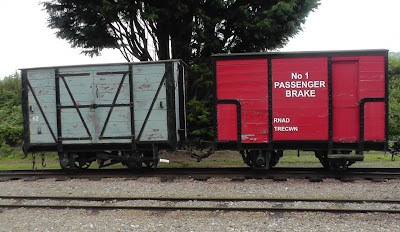 In a nutshell
In a nutshell
Gauge: 2'
Length: 700yd
Opened: 1990s
Location:
Tumblydown Farm,
Tolgus Mount,
Redruth,
West Cornwall.
TR15 3TA
Phone:01209 211191
Mobile: 0751 1256677
Web: http://www.tumblydownfarm.co.uk/museum.html
Email: colinsaxton494@btinternet.com
Date of visit: 8 June 2015
Key Facts
- The museum was originally started by Colin Saxton as a craft project for pupils at Moseley Boys Grammar School in Cheadle, Cheshire in 1969.
- Over twenty-five years, the railway collection grew to over forty narrow gauge locos with half a mile of track. It became a museum open to the public.
- When the school grounds closed in 1990, the collection was dispersed - some forming the basis of the Moseley Railway Trust which is housed at the Apedale Valley Light Railway near Stoke on Trent, and the rest forming the basis for the collection at Tumbly Down Farm in Cornwall
- The museum now has eight locomotives, many of which are from local sources. Five are battery electric locos and three are diesel.
- There are also around forty items of rolling stock, renovated and maintained by a team of volunteers
- In addition to the railway relics, there is a large collection of vintage toys on display, including clockwork and electric model trains from Hornby, Trix, Lima, ACE and LGB. There is also a large collection of Meccano and Dinky Toys.
- On the site is a display depicting a mine, with original equipment displayed in a realistic setting.
- The museum also houses a working replica of William Murdoch's 1784 steam powered road carriage.
- The museum is not normally open to the public but visits can be arranged by contacting the owner beforehand.
- There is no admission charge but visitors are encouraged to make a donation to museum funds.
Route
My Impressions
Having phoned beforehand to arrange my visit, it was suggested that a Monday would be a good day, as this was when the volunteers would be on site. I duly arrived shortly after lunch time and made my way into the main museum building which houses an impressive array of vintage model railway equipment. At the centre was a large Hornby Dublo layout with eight independent circuits.
Around the edges and in various nooks and crannies was an assortment of other model railway exhibits, such as LGB, ...
... Triang TT, ...
... Trix Twin and Hornby 0 gauge.
Another room was in the process of being refurbished to hold the museum's collection of Meccano models:
Although this was of great interest to me as a railway modeller of many decades standing, my primary purpose in visiting the museum for the purpose of this blog, was to view the narrow gauge railway artefacts. These were housed in a couple of sheds and workshops:
The museum has accumulated a number of battery electric vehicles which served in local tin and mineral mines. In addition, there was a range of internal combustion locomotives of varying vintages and origins.
Outside, a 700 yard two foot gauge line has been laid around some of the paddocks belonging to the farm and on the day of my visit, a BEV which formerly operated in the Geevor tin mine was coupled-up ready for a trip.
There are a couple of passing places on the railway, which has a balloon loop at its far end
After negotiating the loop ....
... we set off back up the line.
The loco running round its train at the main terminus, where there is an interesting collection of trackwork serving the various sidings and shed roads.
After browsing the museum exhibits in more depth, including seeing the Hornby Dublo layout in operation, and joining the workforce for a very welcome cup of tea, I explored the museum's re-creation of a coal mine in which exhibits are displayed in realistic tableau settings.
Colin, the museum's owner, talked me through the history, origins and workings of the site's replica of the steam road vehicle which was developed in 1784 by William Murdoch. Apparently, it was being prepared for a run in a local gala that weekend.
There is no admission charge, but a donation to keep this unique collection maintained is, to my mind, well deserved. My only regret is that I was unable to spend more time there and that it is so far away from where I live, otherwise I would become a more frequent visitor. I feel there is so much I was unable to see and experience in the time I had available.




































